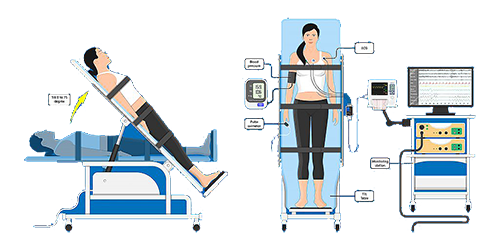Tilt table test is used to evaluate the cause of unexplained fainting (syncope).This test may be recommended a tilt table test if you have repeated, unexplained episodes of lightheadedness, dizziness or fainting. The test can help determine if the cause is related to your heart rate or blood pressure.
A tilt table test is done to try to trigger signs and symptoms — lightheadedness, dizziness or fainting — while the heart rate and blood pressure are being monitored.

Preparation
It is a requirement of the tilt test that you fast for 16 hour prior to the test. This means no food and no water/minimal water so that you can take your usual medications. You can take your usual medications unless the doctor tells you otherwise. If you are diabetic, you are required to fast for 6 hours and you are asked to contact the clinic regarding your medication for further details.
To prepare you for the test, a member of your health care team will:
- Have you lie flat on the table that has a footboard and place straps around you to hold you in place.
- Place sticky patches (electrodes) on your chest, legs and arms. Wires connect the electrodes to an electrocardiogram machine that monitors your heart rate.
- Place a blood pressure monitor or cuff on your finger, on your arm or on both to check your blood pressure during the test.
Procedure:
- You’ll start by lying flat on your back on the motorized table for about five minutes.
- You’ll be moved to a nearly vertical position, where you’ll remain for 2-5 minutes. While vertical, you’ll be asked to remain as still as possible but to report signs and symptoms such as nausea, sweating, lightheadedness or irregular heartbeats.
- You then remain in the upright position for another 15 to 20 minutes.
Your heart rate, rhythm and blood pressure will be monitored in each position to evaluate your body’s cardiovascular response to the change in position.
If you faint while vertical, the table will be returned to a horizontal position immediately, and you’ll be monitored. Most people regain consciousness almost immediately.
In some cases, if blood pressure and heart rate changes indicate you are about to faint, the table is returned to a horizontal position so that you don’t lose consciousness.
When the test is complete, you can return to your normal activities.
Risks
A tilt table test is generally safe, and complications are rare. But, as with any medical procedure, it does carry some risk.
Potential complications include:
- Nausea and vomiting after fainting
- Weakness that can last several hours
- Prolonged low blood pressure (hypotension) after the test
These complications usually go away when the table is returned to a horizontal position.